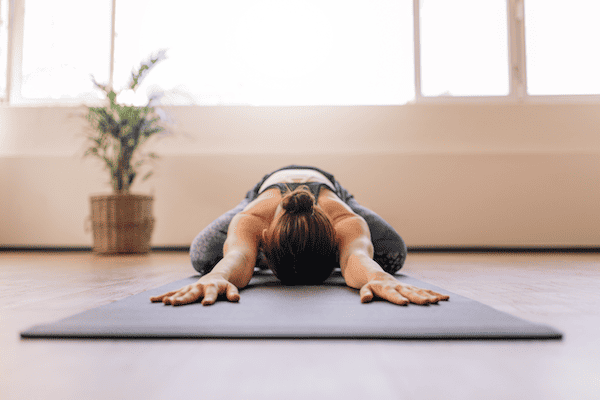
Do you experience neck pain, difficulty turning your head, or headaches? Upper Cross Syndrome, or Upper Crossed Syndrome, is a common neck problem that can manifest with a variety of symptoms. Whether you may be experiencing this issue yourself or you’re a yoga teacher or yoga therapist looking to help clients who face this problem, there are a variety of ways to use yoga for Upper Cross Syndrome with great results.
I’m Brandt Passalacqua, the Founder, Director, and Lead Teacher of Breathing Deeply, a yoga therapy training program. I’ve worked directly with numerous clients suffering from Upper Cross Syndrome and its counterpart, Lower Cross Syndrome, and trained many other yoga therapists on how to address these conditions.
Keep reading to learn more about what this syndrome is, its causes and symptoms, and how to correct it with an example sequence of 7 Upper Cross Syndrome yoga poses and breathing techniques. You can also contact us about working with myself or another yoga therapist I’ve trained to address your neck problems online, or apply to one of our programs if you’re interested in becoming a yoga therapist yourself.
Table of Contents:
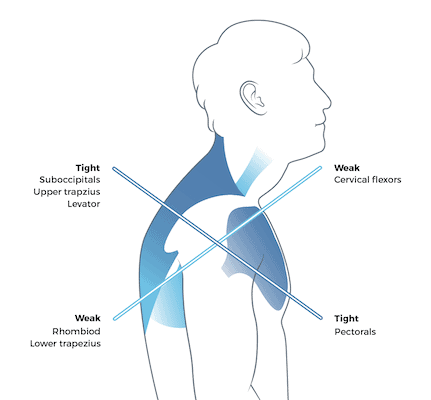
Upper Cross Syndrome (UCS), sometimes also referred to as Upper Crossed Syndrome, is a musculoskeletal disorder that is caused by muscle imbalances in the upper body. This condition is characterized by extreme muscle tightness, reduced range of motion, neck and shoulder pain, and headaches.
Poor posture, especially from sitting for long periods of time, is the leading cause of Upper Cross Syndrome. But it can also be caused by overuse of muscles in your shoulders, neck, or upper back. If these muscles are imbalanced—whether they are too tight, weak, or overworked—it can result in Upper Cross Syndrome.
Recently, I’ve worked with a number of clients who came to me with complaints about their necks:
Even though each person had a different story and complaint, they shared one thing in common: their posture was quite similar. Their heads were pushed forward and their shoulders were rounded, indicating Upper Cross Syndrome.
When you spend long periods of time in a hunched forward posture, your chest muscles can become shortened while your mid-back and shoulder muscles become weakened. This leads to a muscular imbalance in the upper body, where the mid-back and shoulder muscles lack the strength to counteract the muscle tightness and shortness in the neck and front of the body.
This muscular imbalance forms an “X” shape when viewed in profile, hence the name of the syndrome. It crosses from the tight upper trapezius and levator scapulae in the shoulder to tight pectorals in the upper chest, and from the weak cervical flexor muscles in the neck to the weak rhomboid and lower trapezius muscles in the upper back. The first cross is overly tight, and the second is too weak to counteract the first’s tightness.

Upper Cross Syndrome affects a large number of people in a range of ages and professions. It is particularly common among:
Repetitive movements and everyday activities that require focusing on something that is in front of the body but below the head can contribute to Upper Cross Syndrome. The condition can affect anyone who remains in a bad posture position for long periods of time.
Several studies have been done showing how Upper Cross Syndrome affects different populations:
In addition to causing neck pain and headaches, Upper Cross Syndrome can affect breathing by altering the position of the rib cage and diaphragm. The tightness in the chest muscles pulls the shoulders forward and downward, which can cause the rib cage to become compressed. This can lead to a decrease in the amount of air that can be inhaled and exhaled, resulting in shallow breathing.
Additionally, the weakened mid-back muscles can cause the muscles in the neck and upper chest to work harder to lift the rib cage during inhalation, which can cause increased tension and fatigue in these muscles. This can further exacerbate the breathing difficulties associated with Upper Cross Syndrome. One of the benefits of yoga is that it can easily incorporate Upper Cross Syndrome breathing exercises.
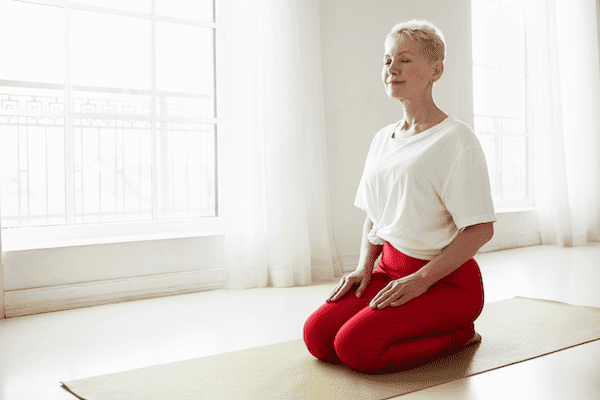
Fortunately, Upper Cross Syndrome can be corrected! When the three clients of mine I mentioned earlier corrected their postures, their symptoms diminished or vanished.
Most interesting to me is the client with arthritis. He had seen a medical doctor and a physical therapist and was convinced that he was doomed because of his diagnosis. It only took 2 minutes for me to correct his posture and get him completely out of pain!
Of course, it can take a little more time to strengthen the muscles that have been weakened to the point where your posture can be corrected for the long term. Keep reading to learn how to use yoga for Upper Cross Syndrome correction.
Upper Cross Syndrome can be corrected with a combination of strengthening, stretching, and lifestyle changes.
Consistency and regularity in performing these exercises are important, as well as fixing any poor posture. Yoga can be a highly effective way to fix this issue, addressing not only the strengthening and stretching exercises with effective yoga poses for Upper Cross Syndrome, but also incorporating breathing techniques and improving mental health to support these efforts.
As mentioned above, there are plenty of highly effective ways to use yoga for Upper Cross Syndrome. Yoga can help to stretch tight muscles and strengthen weak or underactive muscles, which can alleviate tension and remedy imbalances in your posture. The most important point is to focus on strengthening muscles that keep proper alignment without forcing the body into alignment it isn’t ready for.
Yoga also possesses a few unique benefits to help with Upper Cross Syndrome:
My general approach to putting Upper Cross Syndrome yoga poses in a sequence looks something like this: moving and breathing, then strengthening, then stretching. Below is a very simple sequence of yoga for Upper Cross Syndrome using this method, keeping in mind that there are a dozen other sequences to achieve the same goal.
As you can see, several rounds of moving and breathing with Cat-Cow Pose (Bitilasana), Child’s Pose (Balasana), and Warrior 1 Pose (Virabhadrasana I) prepare the joints for the static Cobra Pose (Bhujangasana), which focuses on strengthening. I recommend doing Cobra Pose while tucking the chin in order to strengthen the cervical flexors and the muscles between the scapula (shoulder blades), while also releasing the suboccipitals.
We then spend 16 breaths stretching the pecs with Supine Spinal Twist (Supta Matsyendrasana) so that they get the message to lengthen. This is followed by rest and relaxation in Corpse Pose (Savasana). And that’s it. Keep it simple, clear, and concise.
When we are using yoga poses for Upper Cross Syndrome or to help with other physical problems, my opinion is not to get fancy. It is better to be economical and clear. As yoga therapists, we work with our clients to empower them to fix their health issues.
I’ve seen this type of approach help hundreds of people suffering with neck issues. Yoga asana is really helpful and elegant if we let it be. If you are trying to help others or yourself, go for the most obvious remedy—no matter how simple it might seem—and work from that place.
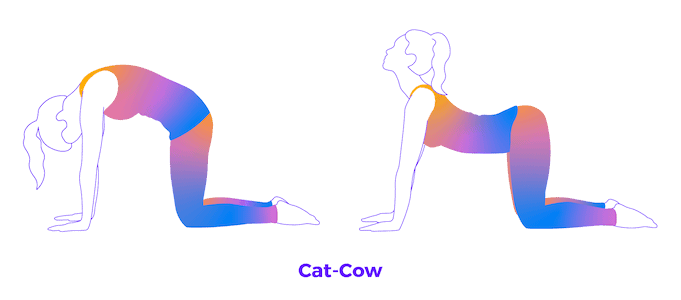
Cat-Cow Pose helps stretch and strengthen the neck, shoulders, and spine, improving posture and reducing tension. This makes it a great Upper Cross Syndrome yoga pose to start with. Those with physical limitations can use props like blankets or blocks for support.
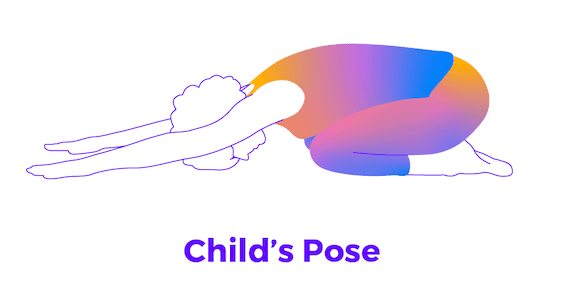
Child’s Pose helps to relieve tension in the neck, shoulders, back, and hips. You can use a pillow or blanket if needed to provide cushioning for your knees or head.
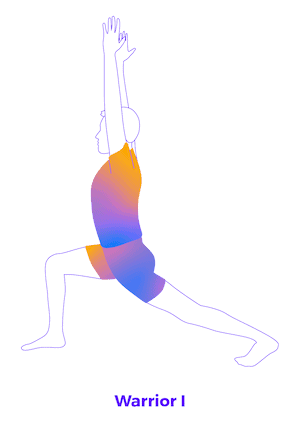
Warrior 1 Pose helps to stretch the chest, shoulders, back, and neck. This makes it an excellent option for Upper Cross Syndrome yoga poses, since these areas are often tight in those with UCS. It also strengthens the legs, glutes, and hips, improving overall stability and balance.
In this version, we tuck the chin and pull the scapula (shoulder blades) together to address the posture imbalances of UCS. When you’re extending yourself toward the ceiling with this pose, you’re training your body to hold an upright posture, correcting the issues found in Upper Cross Syndrome.
To modify the pose, you can reduce the angle of the forward knee or widen your stance to make it easier to balance.
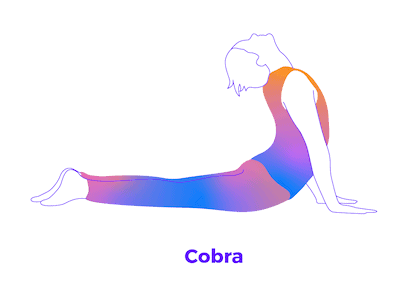
Cobra Pose is an excellent choice when using yoga for Upper Cross Syndrome. It helps to alleviate the symptoms of UCS by strengthening the muscles between the scapula (shoulder blades) and releasing the suboccipitals, which can help to reduce neck and shoulder pain. If you have limited mobility, you can modify the pose by keeping your elbows bent.

Child’s Pose is a restorative yoga pose that not only stretches your neck, shoulders, and back, but also helps you to de-stress. Returning to Child’s Pose here provides a restorative break in the sequence, allowing for a moment of relaxation and reflection before moving onto the next Upper Cross Syndrome yoga pose.
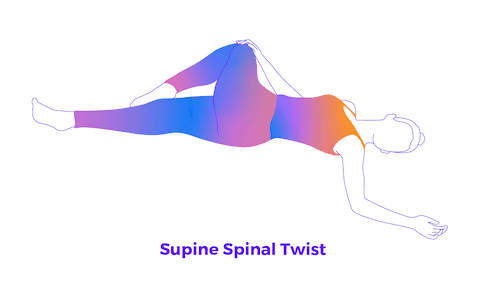
Supine Spinal Twist can help release tension in the neck, shoulders, and back, while also improving spinal mobility. You can modify the pose if needed by placing a cushion or block under your knees.
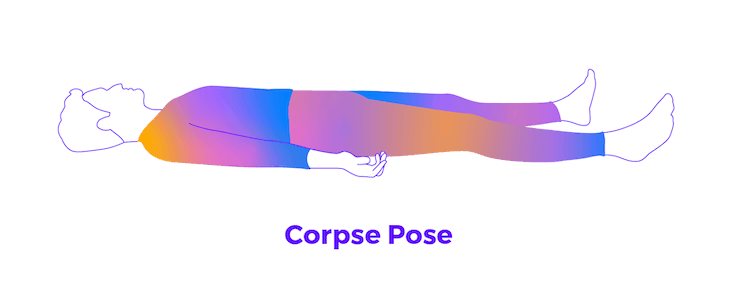
Corpse Pose is a restorative, restful pose, making it a great place to conclude a sequence of yoga for Upper Cross Syndrome. This pose helps to increase your awareness of your body and its posture while also relaxing it.
For those suffering from Upper Cross Syndrome, Corpse Pose can help to unhunch your shoulders, open your chest and neck, and release tension through the front of your body. If needed, you can use a cushion to support your head and neck.
There are a number of Upper Cross Syndrome breathing exercises you can incorporate into your yoga sequence or perform on their own.
For those who experience shallow breathing or difficulty breathing due to Upper Cross Syndrome, breathing exercises can also help combat these symptoms.

Yoga therapy, or the practice of applying yoga techniques to specific health conditions, offers people another path to good health, healing, and well-being, especially when Western medicine has failed them. For over a decade, I’ve made it my mission to make yoga therapy more accessible, both through my own private yoga therapy practice where I’ve helped thousands of clients, and through my yoga therapy programs where I’ve trained hundreds of yoga therapists.
I’ve seen firsthand how incredibly effective it can be to use yoga for Upper Cross Syndrome and other sources of neck pain. Whether you’re looking for relief for yourself or for your yoga students or clients, I’d like to help.
To become a client, contact us today about working with me or one of the yoga therapists I’ve trained. We offer private, online yoga therapy sessions via Zoom.
To become a yoga therapist yourself, learn about our yoga therapy training programs and apply today. New classes will be starting soon!
Brandt talks about common questions applicants have about the Breathing Deeply Yoga Therapy Program. Tune in to get the full program details.
Friends in Yoga, The way we perceive the world is a curious thing. Is it on fire or getting better? Are we facing our challenges or shying away from them? Are we functioning from the present or some altered reality based on past experiences? The teachings tell us that reality is ultimately timeless. The vibration […]
There’s no doubt that yoga is gaining popularity, but you may be asking yourself, what is the most popular type of yoga? Where is each type most popular in the U.S. and around the world? And for those who are interested in trying it themselves, how can you practice these styles of yoga safely? For […]
Friends in Yoga, Sitting on a cushion, taking a yoga class, chanting a mantra before your morning coffee…no one would call these radical acts. They are small choices that we make to better ourselves. The motivation to practice often takes form by our desire to be healthier, to be more focused, to connect with our […]